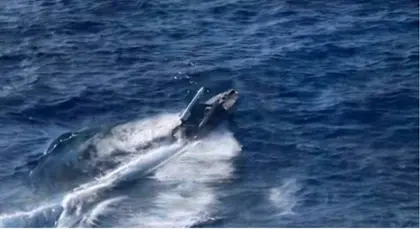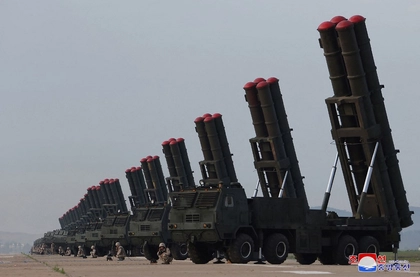In an interview with Ukrainska Pravda in March, Kyrylo Budanov, the Head of Ukraine’s military intelligence directorate (HUR), said Ukraine was actively working on developing both the offensive and defensive capabilities of the Magura V5 unmanned surface vessel (USV) or, more colloquially, the marine attack drone. He said one option was to use it as a seaborne platform for air defense equipment.
The video and images that appeared, initially on Russian milbloggers’ social media, seemed to show that Budanov’s prediction had been made flesh.
JOIN US ON TELEGRAM
Follow our coverage of the war on the @Kyivpost_official.
Analysis of the USV shows it has been fitted with an aircraft rail launcher, probably taken from the underwing hardpoint of an unserviceable Soviet-era fighter, fixed to the drone's body supporting two R-73 air-to-air missiles angled slightly upward towards the bow.
Exactly how the missiles would acquire and lock on to a target, how the system would compensate from the pitch and roll of the sea, how the system would be powered and how the pre-launch preparations for even a relatively simple missile such as the R-73 would be carried out have yet to be answered. Based on other innovations Ukraine’s forces have come up with in the war Russia started more than two years ago, the solution will undoubtedly be simple and pragmatic.
Why the R-73?
The obvious answer is because they were readily available, it’s relatively simple to use and cheap to acquire.

‘We’ll All Die as One for the Tsar’ – Man Fears Putin Turning Russia into North Korea
The Vympel R-73 (NATO: AA-11 Archer) is a short-range air-to-air missile that entered service in 1984 and is, therefore, a relatively simple, even unsophisticated, missile compared with the more modern varieties available to Ukraine. Another reason for choosing it is it has a history of use as a surface-to-air (and even surface-to-surface) missile.
R-73 missile fitted underwing. Photo: wikicommons
In the 1990s Serb forces used R-73s as surface-to-air missiles, as did the Houthi movement against Saudi aircraft. The R73 was the base missile which India modified in creating its SAMAR-1 surface-to-air system.
The R-73 uses an active infrared homing head, meaning it only needs to be pointed in the general direction of its target and will then find its own way to the target. The missile has a theoretical target lock range of 8–12 kilometers (5-7.5 miles), although, in my opinion, it is probable that, in the current Black Sea scenario, engagement is likely to be at much shorter ranges.
It is also unclear whether the intention is to use the Magura / R-73s to “hunt” Russian helicopters and low-flying aircraft or to merely defend itself against enemy attempts to intervene during its primary “kamikaze” mission.
The size of the explosion during Tuesday’s encounter suggests the USV was also carrying its normal ± 200-kilogram suicide explosive payload.
Naval News described in December how Russian forces were deploying the Beriev Be-12 Chakaya (NATO: Mail) anti-submarine turboprop aircraft as well as Ka-29 (NATO: Helix), the attack variant of the Ka-27 naval helicopter, to intercept Ukrainian USV as well as installing booms, nets, barges and other obstacles around static targets such as the Crimean bridge and Sevastopol’s naval base.
Other missile options
The experts from Ukraine’s Defense Express (DE) military news site also looked at other options the HUR could have considered (and may still be considering) to provide the Magura with an air defense capability, which I have also considered although in a different order than the journal did.
Firstly, an obvious candidate would be a man-portable air defense system (MANPADS) such as the 9K32 Strela-2 (NATO: SA-7 Grail), 9K34 Strela-3 (NATO: SA-14 Gremlin), the US FIM-92 Stinger or another of the MANPADS provided from the West. The issue here is not only technical, as DE points out, the relatively small warheads (± 2-3 kilograms) compared with the R-73’s 8 kilograms, would be less lethal and be less likely to acquire the target from such an unstable platform.
For me the other overriding consideration is availability both in the numbers Ukraine holds and the fact that the MANPADS are desperately needed for air defense on the front lines in eastern and southern Ukraine.
DE considered the 70mm AGR-20 Advanced Precision Kill Weapon System (APKWS) currently deployed on land on the L3Harris Vehicle-Agnostic Modular Palletized ISR Rocket Equipment (VAMPIRE) vehicle. While having a lot seemingly going for it in terms of size, weight, and on-target effect the big drawback is the need for stable, laser designation to guide the missile onto its target. As DE argues, the technical issues and probable cost for such a system would unjustifiable for a platform that is ultimately designed to self-destruct.
APKWS missile fired from a pickup truck in 2022. Photo: L3Harris Inc.
Another missile considered by DE was the UK’s Brimstone which would be acceptable in size and weight, uses its own integral radar homing seeker for target acquisition and guidance, has a sizeable 6.3-kilogram tandem warhead which would allow it to engage targets other than airborne threats such as the obstacles laid to prevent USV ingress and to supplement the suicide payload against ships or land targets. Again, cost and availability could be an issue as there are other more urgent uses for the missiles.
At the end of the day, in terms of missiles, the R-73 seems a more than effective compromise in terms of potential ease of use, effectiveness, cost and availability.
Other possible variations
The uses of the Magura V5 in other configurations are really only limited by the imagination and technical capabilities of its users and developers.
If an offensive capability is the driver they could for instance be fitted with auto-firing cannon, anti-armor weapons, mortars, incendiary or thermobaric weapons.
They could be used for covert long-range surveillance and target acquisition for other weapons systems such as Storm Shadow/SCALP, ATACMS or, perhaps in the future, Germany’s TAURUS missiles.
They could also carry out reconnaissance of possible landing sites for seaborne landings and assault, both overt and covert.
Ultimately Magura V5, like its cousin the SBU’s Sea Baby, has an already proven capable in its use as a kamikaze attack drone responsible for driving most, if not all, of Russia’s Black Sea Fleet to run for cover.
You can also highlight the text and press Ctrl + Enter












